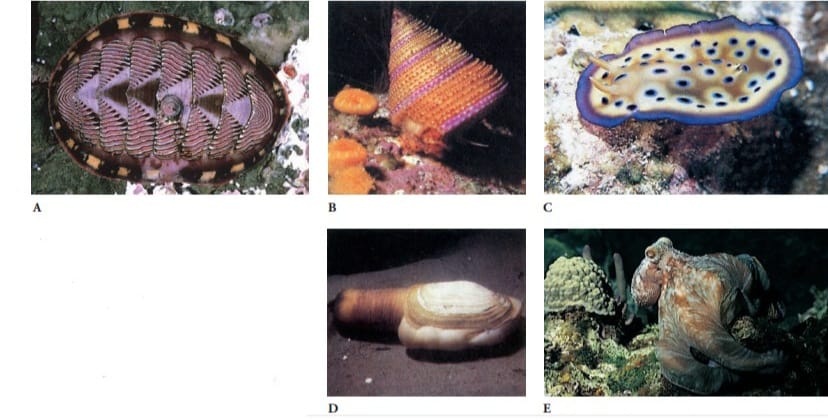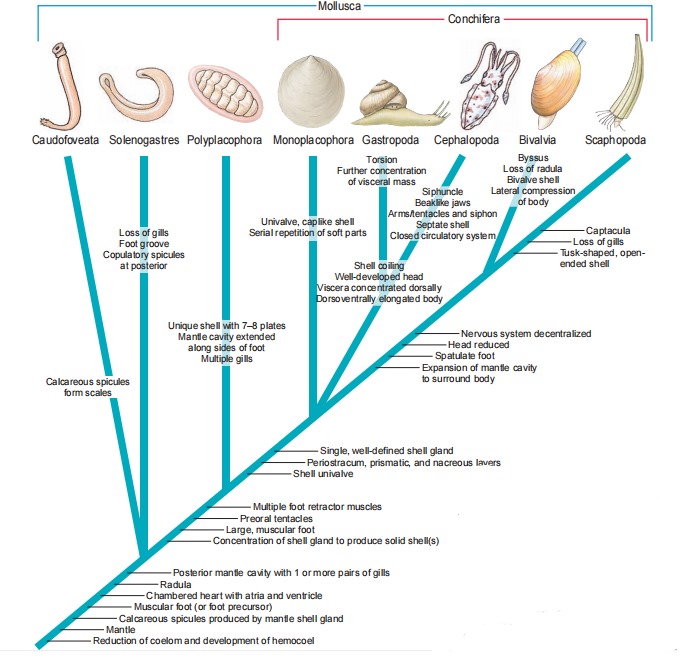Mollusca (mol-lus’ ka) (L. molluscus, soft) is one of the largest animal phyla after Arthropoda. There are over 90,000 living species and some 70,000 fossil species. Molluscs are coelomate lophotrochozoan protostomes, and as such they develop via spiral mosaic cleavage and make a coelom by schizocoely. The ancestral larval stage is a trochophore, but development is variously modified within the classes.
The name Mollusca indicates one of their distinctive characteristics, a soft body. This very diverse group includes chitons, tusk shells, snails, slugs, nudibranchs, sea butterflies, clams, mussels, oysters, squids, octopuses, and nautiluses. The group ranges from fairly simple organisms to some of the most complex of invertebrates; sizes range from almost microscopic to the giant squid Architeuthis. These huge molluscs may grow to nearly 20 m long, including their tentacles. They may weigh up to 900 kg (1980 pounds).

The shells of some giant clams, Tridacna gigas, which inhabit Indo-Pacific coral reefs, reach 1.5 m in length and weigh more than 250 kg. These are extremes, however, for probably 80% of all molluscs are less than 10 cm in maximum shell size. The phylum includes some of the most sluggish and some of the swiftest and most active invertebrates. It includes herbivorous grazers, predaceous carnivores, filter feeders, detritus feeders, and parasites.
Molluscs are found in a great range of habitats, from the tropics to polar seas, at altitudes exceeding 7000 m, in ponds, lakes, and streams, on mud flats, in pounding surf, and in open ocean from the surface to abyssal depths. They represent a variety of lifestyles, including bottom feeders, burrowers, borers, and pelagic forms.
According to fossil evidence, molluscs originated in the sea, and most of them have remained there. Much of their evolution occurred along the shores, where food was abundant and habitats were varied. Only bivalves and gastropods moved into brackish and freshwater habitats. As filter feeders, bivalves were unable to leave aquatic surroundings. Only slugs and snails (gastropods) actually invaded the land. Terrestrial snails are limited in their range by their need for humidity, shelter, and presence of calcium in the soil.
Humans exploit molluscs in a variety of ways. Many kinds of molluscs are used as food. Pearl buttons are obtained from shells of bivalves. The Mississippi and Missouri river basins and artificial propagation furnish material for this industry in the United States. Pearls, both natural and cultured, are produced in the shells of clams and oysters, most of them in a marine oyster, Meleagrina, found around eastern Asia.
Some molluscs are considered pests because of the damage they cause. Burrowing shipworms, which are bivalves of several species , do great damage to wooden ships and wharves. To prevent the ravages of shipworms, wharves must be either creosoted or built of concrete (unfortunately, some shipworms ignore creosote, and some bivalves bore into concrete). Snails and slugs frequently damage garden and other vegetation. In addition, snails often serve as intermediate hosts for serious parasites of humans and domestic animals. Boring snails of genus Urosalpinx rival sea stars in destroying oysters.
In this chapter we explore the various major groups of molluscs including those groups having limited diversity (classes Caudofoveata, Solenogastres, Monoplacophora, and Scaphopoda). Members of class Polyplacophora (chitons) are common to abundant marine animals, especially in the intertidal zone. Bivalves (class Bivalvia) have evolved many species, both marine and freshwater. Class Cephalopoda (squids, cuttlefish, octopuses, and their kin) contains the largest and most intelligent of all invertebrates.

Most abundant and widespread of molluscs, however, are snails and their relatives (class Gastropoda). Although enormously diverse, molluscs have in common a basic body plan . The coelom in molluscs is limited to a space around the heart, and perhaps around the gonads and part of the kidneys. Although it develops embryonically in a manner similar to the coelom of annelids, the functional consequences of this space are quite different because it is not used in locomotion.
Useful External Links
- mollusk by Luitfried Salvini-Plawen
- The evolution of molluscs by Tim Wollesen
- Mollusca (Molluscs) by Gerhard Haszprunar

